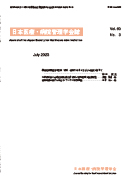Volume 60, Issue 3
Displaying 1-4 of 4 articles from this issue
- |<
- <
- 1
- >
- >|
Perspective
-
2023 Volume 60 Issue 3 Pages 85
Published: July 31, 2023
Released on J-STAGE: December 15, 2023
Download PDF (123K)
Original article
-
2023 Volume 60 Issue 3 Pages 86-94
Published: July 31, 2023
Released on J-STAGE: December 15, 2023
Download PDF (403K)
Research note
-
2023 Volume 60 Issue 3 Pages 95-103
Published: July 31, 2023
Released on J-STAGE: December 15, 2023
Download PDF (357K)
Editorial
-
2023 Volume 60 Issue 3 Pages 104
Published: July 31, 2023
Released on J-STAGE: December 15, 2023
Download PDF (165K)
- |<
- <
- 1
- >
- >|
